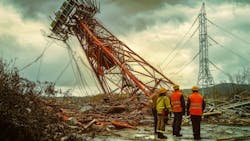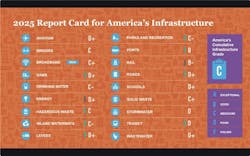ASCE Infrastructure Report Card on Energy: A D+ is Really Failing in Era of Electrification and AI
The imperiled state of U.S. energy infrastructure, already losing luster as the new decade dawned, is now even more in need than it was four years ago.
In fact, energy generation and delivery will require at least $1.89 trillion of near-term future investment to reach a healthy state of repair and keep up with the era of expanding electrification.
The dire and potentially costly warning comes from the latest America’s Infrastructure Report Card by the American Society of Civil Engineers (ASCE). The report card, released Tuesday morning by the ASCE, is published once every four years.
The demand for electrification is elevating in nearly every way, from data centers to reshoring of manufacturing and vehicle electrification. However, the U.S. grade for energy infrastructure to meet that growing connection is faltering, dropping to a D+ in 2025 from the C- assessed by the ASCE in 2021.
“Energy demand is growing faster than it has in two decades,” Otto Lynch, an electric transmission engineer and CEO of Power Line Systems who helped craft the report card as part of the ASCE Committee on America’s Infrastructure, said in the Monday press conference announcing the findings.
“Despite billions in transmission and distribution investment, power generation has stayed the same,” Lynch pointed out. “The demands are rising, and we won’t be equipped to handle that demand until new resources are brought online and quickly.”
Energy: One of only two sectors falling a grade
Energy wasn’t alone among U.S. sectors getting the proverbial dunce cap grading by many of the nation’s top civil engineers, but it was one of only two which dropped a grade compared with the 2021 ASCE Infrastructure Report Card.
Other infrastructural sectors receiving D grades, which ASCE classified as “poor, at risk,” include aviation, dams, levees, roads, schools, transit, stormwater and wastewater sectors.
Power Reliability Needs Spur Microgrid Growth
New Webinar Free and on Demand
Only rails and ports earned B-level plaudits from the ASCE. The remaining sectors--bridges, broadband, drinking water, hazardous waste, inland waterways, public parks and solid waste--graded at “mediocre” Cs.
No sector earned As under the report card’s methodology.
Previously some industry experts, noting the need for massive upgrades in an era of climate change, have told EnergyTech that U.S. infrastructure is at risk of downgrading into a “second world country.” The ASCE report says no such thing verbatim but does stress that lack of investment imperils the nation’s critical facilities and services to its people.
Funding gaps and future demand
“With the 2025 Report Card for America’s Infrastructure, ASCE estimates investment needs total $9.1 trillion for 18 categories to reach a state of good repair,” reads the executive summary, which does note that public and private investments so far are forecast at about $5.4 trillion, which “leaves a gap of $3.7 trillion in investments for America’s infrastructure if we keep investing at current funding levels.”
The funding gap for the U.S. energy sector—what is being spent compared with what’s needed—stands at about $578 billion, according to the ASCE.
“An increase in electric vehicles and a rise in data centers will demand 35 GW of electricity by 2030 alone, up from 17 GW in 2022,” reads the energy snapshot of the ASCE Infrastructure Report Card. “This rapid acceleration, compounded by federal and state net zero greenhouse gas emission goals, means utilities will need to double existing transmission capacity to connect new renewable generation sources.”
Presumably, a substantial portion of these renewables could be distributed energy resources and microgrid assets, which can provide resiliency at the edge of the grid. The Biden Administration-era Infrastructure, Investment and Jobs Act in 2021 and Inflation Reduction Act (IRA) one year later dedicated hundreds of billions toward domestic energy infrastructure improvement, as well as the addition of the IRA’s funding and incentives for low and no-carbon projects such as microgrids and distributed energy projects.
Even so, the demand curve is rising dramatically beyond most previous expectations. Other forecasts, such as Bloom Energy and Goldman Sachs, have predicted as much as 50 GW in new data center capacity over the coming decade.
Recapturing momentum and streamlining interconnection
During the press conference, the ASCE’s Lynch acknowledged the role for distributed energy resources, including battery storage, to strengthen electricity delivery, but repeated that the ultimate need is for more investment in delivery infrastructure such as “poles and wires.”
The arrival of the Trump Administration has resulted in the potential undoing of many Biden initiatives. President Trump has frozen some funding from the IRA, which along with the Infrastructure Investment and Jobs Act have incentivized greater spending on renewable and grid hardening technologies, the ASCE wrote.
“It is critical for the current administration and Congress to maintain that investment,” said Darren Olson, chair of the ASCE’s Committee on America’s Infrastructure, the group of about 52 civil engineers who worked on the reports.
The weather also is getting nastier in recent years, accounting for 80% of electricity outages since 2000, most of those in the past decade. The ASCE estimated that weather events cost close to $182 billion in property damage in 2024.
Time can also be an enemy of progress in the energy sector. The nation’s interconnection queue, the process by which new projects are approved by several regulatory jurisdictions, can take several years to complete a clean energy project from design to construction to commissioning.
“Interregional connections accelerated by streamlined regulatory review, rigorous design standards and resilient technologies must be implemented to ensure reliability in the years ahead,” reads the ASCE’s review of energy investment needs.
Some of the nation’s biggest economic entities are so worried about utility grid resiliency that they are moving forward with alternate plans to build both natural gas-fired and perhaps off-grid power systems.
Most of the major data technology firms, including Microsoft and Google, are exploring future energy deals with nuclear technology firms to expand access to GWs of capacity.
EnergyTech.com is part of Endeavor Business Media
EBM's Comprehensive Coverage of the ASCE Report Card
From Aviation to Energy to Water, Roads and Bridges
About the Author
Rod Walton, EnergyTech Managing Editor
Managing Editor
For EnergyTech editorial inquiries, please contact Managing Editor Rod Walton at [email protected].
Rod Walton has spent 17 years covering the energy industry as a newspaper and trade journalist. He formerly was energy writer and business editor at the Tulsa World. Later, he spent six years covering the electricity power sector for Pennwell and Clarion Events. He joined Endeavor and EnergyTech in November 2021.
Walton earned his Bachelors degree in journalism from the University of Oklahoma. His career stops include the Moore American, Bartlesville Examiner-Enterprise, Wagoner Tribune and Tulsa World.
EnergyTech is focused on the mission critical and large-scale energy users and their sustainability and resiliency goals. These include the commercial and industrial sectors, as well as the military, universities, data centers and microgrids. The C&I sectors together account for close to 30 percent of greenhouse gas emissions in the U.S.
He was named Managing Editor for Microgrid Knowledge and EnergyTech starting July 1, 2023
Many large-scale energy users such as Fortune 500 companies, and mission-critical users such as military bases, universities, healthcare facilities, public safety and data centers, shifting their energy priorities to reach net-zero carbon goals within the coming decades. These include plans for renewable energy power purchase agreements, but also on-site resiliency projects such as microgrids, combined heat and power, rooftop solar, energy storage, digitalization and building efficiency upgrades.




